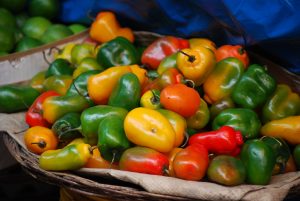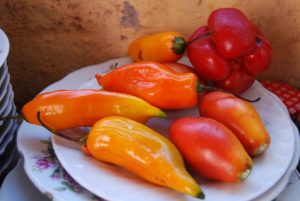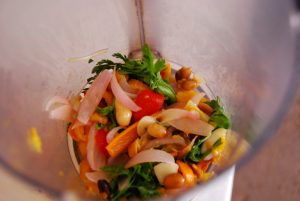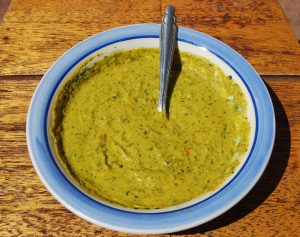Making a Good Hot Sauce at Home

In Cuzco there is a great variety of foods, but there is one thing that must never be missing from the table, no matter the dish. That is a good ají, a hot sauce, or, at the minimum, sliced hot peppers.
The Spanish chroniclers, such as Garcilaso Inca de la Vega, noticed how the Inca always ate hot peppers with their food. That is still the case today among us, the descendants of the Inca.
Cuzqueños love their hot peppers and hot sauces. You will see many houses with a hot pepper bush growing along side their house. Covered with dangling red rocotos it is an emblematic element of the scenery of Cuzco.
Once people sit down to eat, the hot sauce appears on the table. It can be spooned into bowls of soup, to give just that little added seasoning, a bit of brightness and spice to the warm and hearty dish.
But the hot sauce is not just for soups. Once the main course arrives people will add a bright mound of it to their plates to eat a bit with every bite of their well-seasoned baked pork, their chicken still smoky from its grilling, or their guinea pig crispy and juicy right out of the oven.


In fact the only course of the meal that generally does not improve with our hot sauce is dessert.
We have a whole range of hot sauces, each a little different. They can vary according to the kind of pepper, how it is processed, and the additional ingredients. Some are red, some are green and some are yellow. They are a whole palette of colors.
A hot sauce may be as simple as a rocoto diced, salted, and then spritzed with a bit of lime juice.
If the rocoto is finely diced, then finely diced red onion can be mixed with it, the juice of a lime, and salt.
The ají can be enlivened with green herbs such as parsley, the Peruvian favorite cilantro or the black mint we call huacatay that we love in Cuzco.
You can add other ingredients, such as toasted grains, onion greens or the onion itself, cheese, garlic, and so on.

The most common ají, hot sauce, is a blend of ingredients that is either ground on a flat stone that most every house still has in Cuzco, called a batán or in a blender. People prefer the batán. They say it gives a particular flavor and a better texture to the resulting product. In truth, however, more and more people are grinding their sauces in a blender.
Even if you use the blender, you are following our ancient traditions of eating hot peppers with our foods. In fact uchukuta, our word for spicy food, can almost simply be the word for food.
Here is a recipe for a delicious hot sauce. It is one that it is commonly made to accompany cheeses, potatoes, and meats. People will take it with them to eat during their breaks from cultivating the fields or herding their cattle, sheep, and llamas.
Aji with Tree Tomato and Cheese
Ingredients:
1 onion, diced
3 aji mirasols (fresh yellow ají) or yellow rocotos and diced into pieces
1 medium red pepper
3 cloves of garlic
3 tree tomatoes (tamarillos), peeled and sliced.
1 stalk of parsley
1 stalk cilantro
1 stalk huacatay
approximately 1 oz. chicken stock
approximately 1/4 cup roasted peanuts
100 rms. white, fresh cheese such as a Mexican queso fresco or similar
salt to taste.
2 tbs. oil

Preparation:
Heat the oil in a fry pan and lightly toast the onion, rocoto, garlic, and tree tomato until soft. Once softened add to the blender or ginding tool (batán or mortar).
Add the green herbs and the roasted peanuts. Blend, adding broth as needed to make the blend smoother.
Add cheese cut into chunks and blend again, adding broth when needed, until smooth. Rectify salt and serve in a bowl on your table with your meal.

Translators Note:
Tree tomatoes are a different species from the tomato and have a different flavor profile. In English they are generally called tamarillo (solanum betaceum).
For this recipe you could substitute tomatoes although the flavor would be different as would the esthetics. This sauce is a yellow to beige sauce.
Ají mirasol, is the fresh version of the ají amarillo that is classic in Peruvian cuisine, but these peppers are difficult to find outside of Peru. You can, however, buy them frozen in Peruvian groceries and Latin American groceries that serve a Peruvian population.
As a substitute, although again the flavor profile will differ, you can use a yellow chile manzano which is a rocoto cultivated in Mexico, or hungarian or other yellow hot peppers. If none of the above is available, try a yellow sweet pepper and moderate the heat with ground cayenne pepper.
The cheese used in Cuzco is a salty white cheese. It is firmer than Mexican queso fresco (widely available now in the US), and is more like a farmer’s cheese or an Indian paneer. Find one that works best for you.
Every individual cook has their own recipes for sauces and constantly vary the ingredients and techniques to give the result they want to accompany the particular dish of the day. You will have fun improvising with this recipe as your base.




